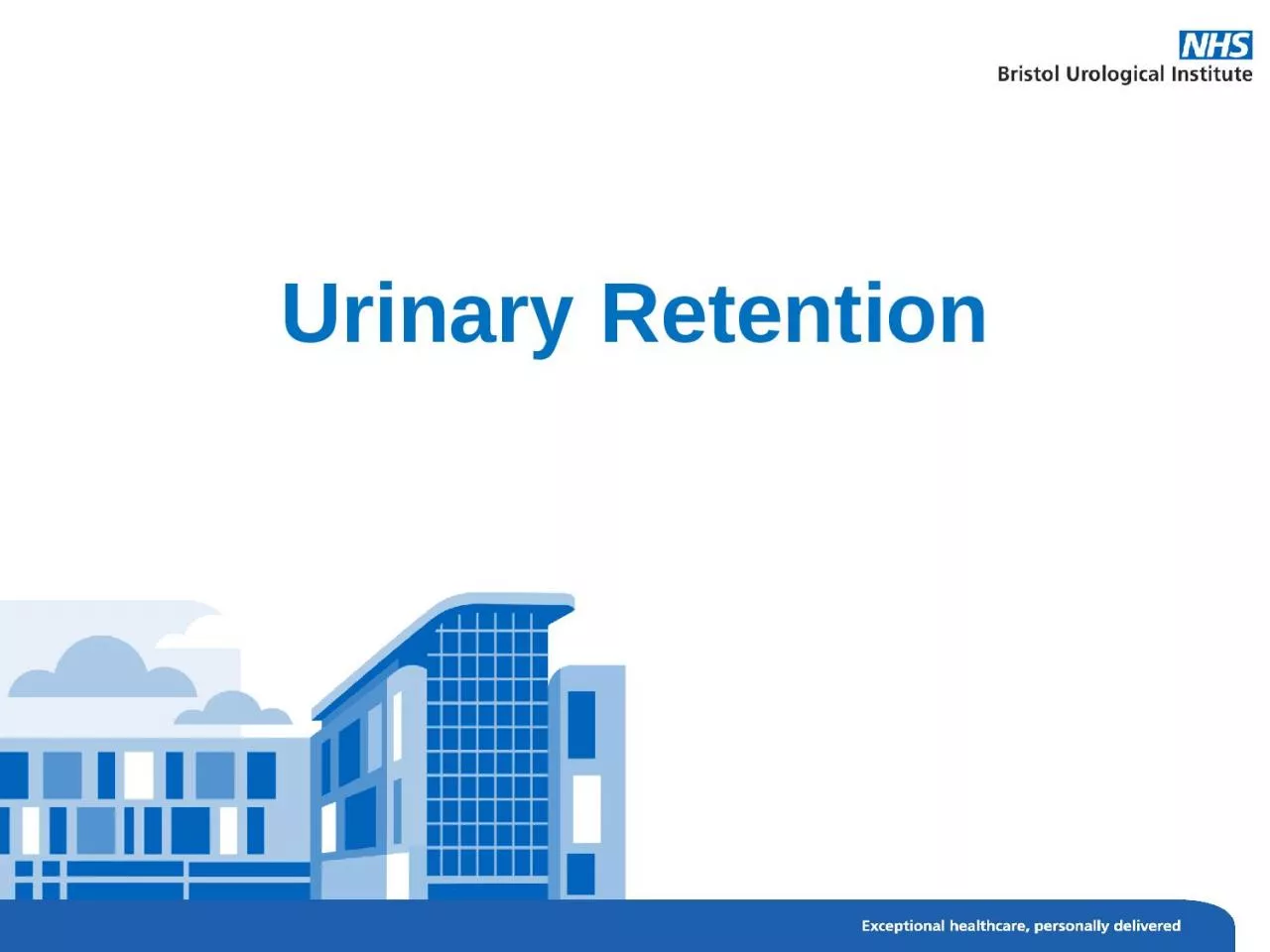

This is described as the painful inability to void with relief of the pain following drainage of a large volume of urine from the bladder The volume is normally between 500800ml Larger volumes suggest an acute on chronic retention picture Acute retention can be spontaneous or precipitated ID: 1040700
Download Presentation The PPT/PDF document "Urinary Retention Acute urinary retenti..." is the property of its rightful owner. Permission is granted to download and print the materials on this web site for personal, non-commercial use only, and to display it on your personal computer provided you do not modify the materials and that you retain all copyright notices contained in the materials. By downloading content from our website, you accept the terms of this agreement.
1. Urinary Retention
2. Acute urinary retention This is described as the painful inability to void with relief of the pain following drainage of a large volume of urine from the bladder. The volume is normally between 500-800ml. Larger volumes suggest an acute on chronic retention picture. Acute retention can be spontaneous or precipitated.
3. Chronic urinary retentionChronic urinary retention is the inability to completely empty the bladder whilst maintaining the ability to urinate, with residual volumes of >300ml. Patients do not suffer from pain, but may have associated symptoms including feeling of incomplete emptying, poor or interrupted stream, and urinary frequency and urgency.
4. High pressure chronic urinary retentionHigh pressure chronic urinary retention is similar to chronic urinary retention. However, it is associated with a tense bladder and renal impairment due to hydronephrosis (dilatation of the kidney). Patients may have similar chronic urinary retention symptoms, including night-time incontinence. Urgent drainage of the bladder is required.
5. Common cause of urinary retention in menUrological Benign prostatic enlargementProstate malignancyUrethral strictureHaematuriaProstatic abscessNon urological Recent surgery (anaesthetic/mobility related) ConstipationDrugs ‐ antidepressants, nasal decongestants, anaesthetic
6. Common cause of urinary retention in womenPelvic prolapsePost surgery Pelvic massesConstipationNeurologicalDrugs - antidepressants, nasal decongestants, anaesthetic
7. Initial management HistoryHPC How long since last voidedPainInfective symptomsHaematuriaAny associated neurological symptomsPMH Recent or previous surgery on lower urinary tract or abdomenPrevious lower urinary tract symptomsDH Any recent medication changesDrugs for benign prostatic enlargement Any anticoagulants
8. Initial managementExaminationObservation and general inspectionExamine abdomen for palpable bladder or other abdominal massesExamine external genitalia for potential causes of obstruction eg phimosisRectal examination in men to examine size and nature of prostateVaginal examination in women to examine for possible pelvic masses
9. Catheterisation Pain reliefOral analgesiaLocal anaesthetic lubrication (e.g. Instillagel)TechniqueObtain equipment needed for catheterisationSterile catheterisation packCleaning fluidSyringe and sterile water for non-prefilled cathetersLubricating jellyCatheterCatheter bag/Drainage system
10. CatheterisationTechnique continued:Wash and dry hands, put on sterile gloves. Place sterile towels to cover patient genitals. In a man, clean the glans penis, and in a woman, urethral meatus and surrounding tissues. Inject lubricating or anaesthetic jelly down urethra, leaving for 5 minutes.Gently insert the catheter through the urethra and into the bladder. Wait until urine flows before inflating the balloon to suggested capacity (see catheter label). Withdraw catheter so that balloon sits at the bladder neck.Connect drainage bag
11. Post catheterisationMeasure residual volume drained Check U&Es Give patient completed catheter passportConsider reversible causes eg constipationConsider starting an alpha blocker if the possible cause if benign prostatic enlargementConsider whether a trial without catheter is suitable and could this be done in community?Communicate with patient the next step in the management plan and document in catheter passport Refer for TWOC if appropriate using the fo+
12. Urinary retention pathwaysMale urinary retention pathway at NBT linkFemale urinary retention pathway at NBT link
13. Referral forms for NBT TWOCClick links below to BUI Website for Male and Female referral formsMale TWOC referral formFemale TWOC referral form